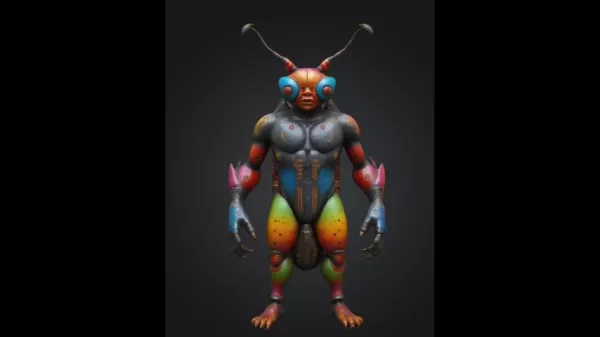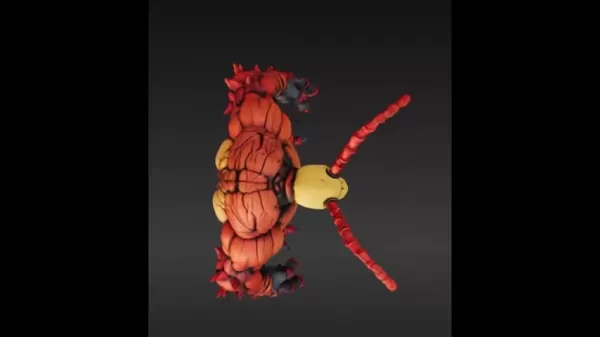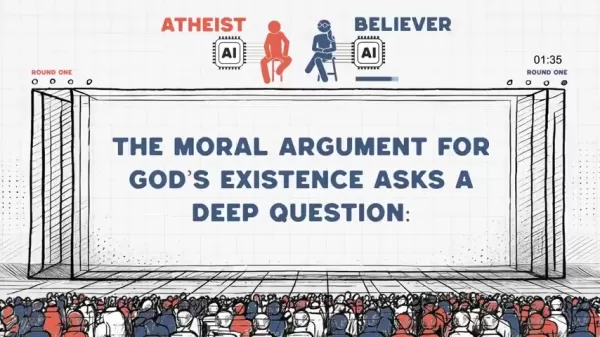AI Text-to-3D Model Showdown: Meshy vs. Tripo vs. Rodin AI
The world of AI-driven 3D modeling is transforming at a breakneck pace, giving designers and creators powerful tools to turn their ideas into reality. In this article, we'll dive deep into a comparison of three leading AI platforms: Meshy, Tripo, and Rodin AI. We'll explore how each one handles the challenge of generating 3D models from text prompts, and we'll scrutinize their abilities to help you choose the best fit for your creative projects. Get ready for a thrilling text-to-3D showdown where AI brings the magic!
Key Points
- Meshy stands out for its clean, well-structured 3D models with optimized geometry, perfect for animation and game development.
- Tripo offers a unique, artistic approach with its stylized wireframes and polished shading, adding a creative twist to 3D model generation.
- Rodin AI shines with its versatile geometry editing capabilities, allowing users to deeply customize their models after initial creation.
- Model quality is assessed by geometric accuracy, detail, and aesthetic appeal.
- Wireframe structure affects the model's flexibility and readiness for animation.
- Texturing and shading play a crucial role in achieving visual realism and artistic flair.
- The best choice depends on your project's needs, whether it's precision in geometry, artistic styling, or the ability to edit post-generation.
Understanding the AI Text-to-3D Landscape
The Rise of AI in 3D Modeling
The integration of Artificial Intelligence (AI) into 3D modeling has truly revolutionized the creative landscape. AI text-to-3D model generation is leading the charge, allowing users to craft intricate 3D objects simply by describing them in text. This not only streamlines workflows but also makes sophisticated design accessible to everyone. With advancements in machine learning, neural networks, and computer vision, these AI tools are becoming more accurate and visually stunning. As AI evolves, its role in 3D modeling will only grow, empowering creators and reshaping industries.
Why Choose AI for 3D Model Creation?
Opting for an AI-driven approach in 3D modeling comes with several compelling benefits:
- Efficiency: AI dramatically cuts down the time needed to create complex models, speeding up project timelines and allowing for more design iterations.
- Accessibility: These tools make 3D design more approachable, enabling even those with limited technical skills to produce sophisticated visuals.
- Creativity: AI encourages design exploration by quickly generating variations and unexpected designs from textual input.
- Cost-Effectiveness: Automating the modeling process with AI can lead to significant savings by reducing labor hours and resource allocation.
- Scalability: AI can handle large-scale modeling projects effortlessly, ensuring consistent quality across numerous assets.
As AI technology continues to evolve, it promises even greater enhancements to the 3D modeling workflow, cementing its importance in the design and creative fields.
Deep Dive into AI Model Strengths
Practical Examples
Imagine a game developer needing a diverse cast of characters. With Meshy, they can swiftly generate base models with clean geometry and optimized wireframes, ready for rigging and animation. For a marketing campaign, the same developer might choose Tripo to create eye-catching stylized renders with vibrant colors and artistic shading. When a character needs precise adjustments to fit a narrative, Rodin AI provides the geometry editing tools necessary for customization.
In architectural visualization, Meshy can produce accurate models of buildings for technical documentation, while Tripo can create visually stunning presentations for clients. Rodin AI allows architects to fine-tune designs, ensuring every detail aligns with their vision.
These examples illustrate how each AI tool can be strategically used based on its strengths, offering tailored solutions for different creative tasks.
Enhancing Workflows with AI: A Detailed Look
Let's delve into a detailed workflow enhancement scenario for a product designer creating a new line of customizable furniture. Using AI can significantly speed up the design process, allowing the designer to focus on innovation and refinement rather than repetitive tasks.
- Initial Model Generation: The designer uses Meshy to generate initial 3D models of the furniture pieces based on text descriptions. Meshy's clean geometry ensures the models are structurally sound and easy to manipulate.
- Artistic Enhancement: Next, the designer employs Tripo to create stylized renders, experimenting with different color palettes and shading styles to visualize various aesthetic options.
- Customization and Refinement: Finally, the designer uses Rodin AI to fine-tune the models, adjusting dimensions, adding intricate details, and ensuring each piece meets specific ergonomic and aesthetic requirements. Rodin AI's geometry editing capabilities are invaluable for achieving the desired level of customization.
This streamlined workflow demonstrates how AI can empower designers to be more efficient, creative, and responsive to market demands.
Step-by-Step Guides
How to Generate a Model with Meshy
- Sign up on the Meshy website and create an account.
- Navigate to the text-to-3D generation tool.
- Enter a detailed text description of the model you want to create.
- Click the generate button to create the initial model.
- Review and refine the model for accuracy and detail.
- Customize the texture for your model.
- Export the optimized model in your desired format for use in your project.
How to Create Artistic Renders with Tripo
- Go to the Tripo platform and log in.
- Upload an existing model or generate a new one using Tripo's text-to-3D feature.
- Experiment with different shading and lighting styles to achieve the desired artistic effect.
- Adjust color palettes to enhance the visual appeal.
- Create high-quality renders for marketing or presentation purposes.
How to Customize Geometry with Rodin AI
- Access Rodin AI and log into your account.
- Use the text-to-3D feature to generate an initial model.
- Enter the geometry editing mode.
- Use Rodin AI's tools to modify dimensions, add details, and refine the overall shape.
- Export the customized model for integration into your project.
Evaluating Pros and Cons of Each AI Tool
Pros of Meshy
- Clean and optimized geometry
- Excellent wireframe structure
- Texture editing capabilities
- Suitable for animation and game development
Cons of Meshy
- May lack artistic flair compared to Tripo
- Geometry editing limited compared to Rodin AI
Comparing Core Features: Meshy, Tripo, and Rodin AI
Text-to-3D Generation Capabilities
All three platforms—Meshy, Tripo, and Rodin AI—focus on text-to-3D generation, but each brings unique strengths to the table. Meshy emphasizes clean geometry and optimized wireframes, making it excellent for creating models ready for animation and game development. Tripo adopts a more artistic approach, resulting in stylized and visually appealing models. Rodin AI differentiates itself through powerful geometry editing capabilities, giving users significant control over refining and customizing their models.
The text prompt used for this comparison was, 'The object is a humanoid bug figure, with a shaped head featuring engraved symbols, a heavily textured, extremely muscular body with bright colors, symmetric.'
Model Quality and Geometry
- Meshy: Meshy creates well-structured models with an emphasis on clean geometry. It's a clear winner based on topology, symmetry, optimization, and animation readiness.
- Tripo: Tripo focuses on artistic interpretations, often resulting in unique and stylized models that stand out visually.
- Rodin AI: Rodin AI offers good model quality, but its real strength lies in the ability to edit the model's geometry after it has been generated by the AI.
Wireframe Structure Analysis
- Meshy: Meshy produces highly optimized and symmetrical wireframes, making the models ideal for rigging and animation pipelines.

- Tripo: Tripo wireframes are denser and more stylized, complementing its artistic rendering approach.
- Rodin AI: Rodin AI wireframes may not be as optimized as Meshy's, but they provide a solid base for geometry editing and customization.
Texturing and Shading Prowess
- Meshy: Meshy delivers solid texturing capabilities with the added benefit of texture editing, enabling users to refine and customize the look.

- Tripo: Tripo excels in shading, producing polished, high-quality renders that make bright colors pop and materials come to life.
- Rodin AI: Rodin AI offers decent texturing, but the real strength is the flexible geometry editing feature.
Use Cases Across Industries: How to Use Meshy, Tripo, and Rodin AI
Game Development
- Meshy: Ideal for creating game-ready assets with clean geometry and optimized wireframes, reducing the need for manual optimization.
- Tripo: Suitable for stylized games where artistic flair and unique visuals are prioritized over geometric precision.
- Rodin AI: Useful for prototyping and rapidly iterating on character or object designs, thanks to its geometry editing capabilities.
Animation
- Meshy: Well-suited for animation projects requiring precise and easily riggable models, ensuring smooth and realistic movements.
- Tripo: Applicable for animations that benefit from stylized shading and unique visual aesthetics.
- Rodin AI: Handy for creating customizable character designs, enabling animators to fine-tune models to fit specific animation needs.
Product Design
- Meshy: Suitable for generating clean and accurate prototypes for product visualization and design validation.
- Tripo: Appropriate for creating eye-catching marketing visuals and showcasing products with artistic flair.
- Rodin AI: Useful for rapidly iterating on product designs and exploring different variations with its geometry editing features.
Architectural Visualization
- Meshy: Ideal for generating detailed architectural models with clean geometry, ensuring accurate representation of building structures.
- Tripo: Applicable for creating artistic and stylized visualizations of architectural designs, focusing on aesthetics.
- Rodin AI: Handy for fine-tuning architectural models and customizing elements to match specific design requirements.
Education
- Meshy: A great learning tool for students looking to learn about model building with the option to customize textures, refine or customize the look of the model.

- Tripo: Best suited for users to create high-quality renders with bright colors with re-topology features for export.
- Rodin AI: Rodin allows users geometry editing, making it more flexible, along with creating t-pose models.
Frequently Asked Questions
What are the primary differences between Meshy, Tripo, and Rodin AI?
Meshy excels in providing optimized geometry and wireframes for animation and game development. Tripo delivers unique artistic styling and polished shading. Rodin AI offers versatile geometry editing for detailed customization.
Which AI is best for creating game-ready assets?
Meshy is the top choice due to its clean geometry and optimized wireframes, reducing the need for manual optimization and ensuring seamless integration into game engines.
Can I customize models after they are generated?
Rodin AI stands out with its geometry editing capabilities, allowing extensive customization after initial model generation. Meshy provides texture editing, while Tripo focuses primarily on artistic rendering.
Which AI is ideal for creating visually stunning marketing materials?
Tripo is perfect for generating eye-catching visuals with vibrant colors and artistic shading, making it ideal for marketing and presentation purposes.
Related Questions
How do AI text-to-3D model generators compare to traditional 3D modeling software?
AI text-to-3D model generators offer significant advantages in terms of speed and accessibility compared to traditional 3D modeling software. AI tools automate complex tasks, allowing users to create models more quickly and with less technical expertise. Traditional software, such as Blender and Maya, provides greater control and precision but requires extensive training and manual effort. AI generators excel in rapid prototyping and design exploration, while traditional software is better suited for highly detailed and specialized projects. Ultimately, the choice depends on the project's specific requirements, budget, and timeline. Both AI and traditional tools have their place in the modern 3D design landscape, and many professionals leverage a combination of both to maximize efficiency and creativity.
Related article
 AI Evaluation Requires Real-World Performance Review Beyond Benchmarks
If you've been tracking AI advancements, you've undoubtedly encountered headlines announcing record-breaking benchmark performances. From computer vision tasks to medical diagnostics, these standardized tests have long served as the definitive measur
AI Evaluation Requires Real-World Performance Review Beyond Benchmarks
If you've been tracking AI advancements, you've undoubtedly encountered headlines announcing record-breaking benchmark performances. From computer vision tasks to medical diagnostics, these standardized tests have long served as the definitive measur
 Atheist and Believer AI Clash Over Moral Argument in Heated Debate
When artificial intelligence systems with diametrically opposed philosophical frameworks engage in ethical debate, what insights emerge? This groundbreaking experiment staged an intellectual confrontation between an Atheist AI and Believer AI, focusi
Atheist and Believer AI Clash Over Moral Argument in Heated Debate
When artificial intelligence systems with diametrically opposed philosophical frameworks engage in ethical debate, what insights emerge? This groundbreaking experiment staged an intellectual confrontation between an Atheist AI and Believer AI, focusi
 OpenAI Upgrades ChatGPT Pro to o3, Boosting Value of $200 Monthly Subscription
This week witnessed significant AI developments from tech giants including Microsoft, Google, and Anthropic. OpenAI concludes the flurry of announcements with its own groundbreaking updates - extending beyond its high-profile $6.5 billion acquisition
Comments (12)
0/200
OpenAI Upgrades ChatGPT Pro to o3, Boosting Value of $200 Monthly Subscription
This week witnessed significant AI developments from tech giants including Microsoft, Google, and Anthropic. OpenAI concludes the flurry of announcements with its own groundbreaking updates - extending beyond its high-profile $6.5 billion acquisition
Comments (12)
0/200
![BillyEvans]() BillyEvans
BillyEvans
 August 4, 2025 at 2:01:00 AM EDT
August 4, 2025 at 2:01:00 AM EDT
¡Qué locura cómo la IA está cambiando el modelado 3D! Meshy parece súper práctico para juegos, pero me pregunto si Tripo o Rodin AI serán más fáciles de usar para principiantes. ¿Alguien ha probado los tres? 😄


 0
0
![FredGreen]() FredGreen
FredGreen
 July 27, 2025 at 9:18:39 PM EDT
July 27, 2025 at 9:18:39 PM EDT
I was blown away by how fast these AI tools can churn out 3D models! Meshy’s clean geometry is a game-changer for game devs like me, but I wonder if Tripo’s stylized renders could steal the show for marketing. Tough choice! 😎


 0
0
![RaymondGreen]() RaymondGreen
RaymondGreen
 May 8, 2025 at 1:22:38 AM EDT
May 8, 2025 at 1:22:38 AM EDT
メシィ、トリポ、ロダンAIの3つを試してみましたが、どれも素晴らしいです!メシィの詳細さは本当に驚きですが、トリポのスピードも最高です!ロダンAIは独特なスタイルでダークホースのようです。難しい選択ですが、今のところトリポに傾いています。皆さんのおすすめは?😎


 0
0
![AnthonyHill]() AnthonyHill
AnthonyHill
 May 7, 2025 at 11:39:17 PM EDT
May 7, 2025 at 11:39:17 PM EDT
Tried Meshy, Tripo, and Rodin AI for my project and honestly, it's like choosing between three awesome superheroes! Meshy's detail is unreal, but Tripo's speed? Chef's kiss! Rodin AI feels like the dark horse with its unique style. Tough choice, but I'm leaning towards Tripo for now. Anyone else got a favorite? 😎


 0
0
![EricRoberts]() EricRoberts
EricRoberts
 May 7, 2025 at 10:35:45 PM EDT
May 7, 2025 at 10:35:45 PM EDT
세 가지 모두 시도해봤는데, Meshy가 제일 마음에 듭니다! 직관적이고 결과도 놀랍습니다. Tripo도 괜찮지만 조금 어색하고, Rodin AI는 글쎄요, 제 취향이 아닙니다. 3D 모델링에 관심이 있다면 Meshy를 꼭 시도해보세요! 🚀


 0
0
![AndrewWilson]() AndrewWilson
AndrewWilson
 May 7, 2025 at 1:38:19 PM EDT
May 7, 2025 at 1:38:19 PM EDT
Experimentei o Meshy, Tripo e Rodin AI para o meu projeto e, honestamente, é como escolher entre três super-heróis incríveis! O detalhe do Meshy é surreal, mas a velocidade do Tripo? Beijo do chef! O Rodin AI parece o cavalo negro com seu estilo único. Escolha difícil, mas estou inclinado para o Tripo por enquanto. Alguém mais tem um favorito? 😎


 0
0
The world of AI-driven 3D modeling is transforming at a breakneck pace, giving designers and creators powerful tools to turn their ideas into reality. In this article, we'll dive deep into a comparison of three leading AI platforms: Meshy, Tripo, and Rodin AI. We'll explore how each one handles the challenge of generating 3D models from text prompts, and we'll scrutinize their abilities to help you choose the best fit for your creative projects. Get ready for a thrilling text-to-3D showdown where AI brings the magic!
Key Points
- Meshy stands out for its clean, well-structured 3D models with optimized geometry, perfect for animation and game development.
- Tripo offers a unique, artistic approach with its stylized wireframes and polished shading, adding a creative twist to 3D model generation.
- Rodin AI shines with its versatile geometry editing capabilities, allowing users to deeply customize their models after initial creation.
- Model quality is assessed by geometric accuracy, detail, and aesthetic appeal.
- Wireframe structure affects the model's flexibility and readiness for animation.
- Texturing and shading play a crucial role in achieving visual realism and artistic flair.
- The best choice depends on your project's needs, whether it's precision in geometry, artistic styling, or the ability to edit post-generation.
Understanding the AI Text-to-3D Landscape
The Rise of AI in 3D Modeling
The integration of Artificial Intelligence (AI) into 3D modeling has truly revolutionized the creative landscape. AI text-to-3D model generation is leading the charge, allowing users to craft intricate 3D objects simply by describing them in text. This not only streamlines workflows but also makes sophisticated design accessible to everyone. With advancements in machine learning, neural networks, and computer vision, these AI tools are becoming more accurate and visually stunning. As AI evolves, its role in 3D modeling will only grow, empowering creators and reshaping industries.
Why Choose AI for 3D Model Creation?
Opting for an AI-driven approach in 3D modeling comes with several compelling benefits:
- Efficiency: AI dramatically cuts down the time needed to create complex models, speeding up project timelines and allowing for more design iterations.
- Accessibility: These tools make 3D design more approachable, enabling even those with limited technical skills to produce sophisticated visuals.
- Creativity: AI encourages design exploration by quickly generating variations and unexpected designs from textual input.
- Cost-Effectiveness: Automating the modeling process with AI can lead to significant savings by reducing labor hours and resource allocation.
- Scalability: AI can handle large-scale modeling projects effortlessly, ensuring consistent quality across numerous assets.
As AI technology continues to evolve, it promises even greater enhancements to the 3D modeling workflow, cementing its importance in the design and creative fields.
Deep Dive into AI Model Strengths
Practical Examples
Imagine a game developer needing a diverse cast of characters. With Meshy, they can swiftly generate base models with clean geometry and optimized wireframes, ready for rigging and animation. For a marketing campaign, the same developer might choose Tripo to create eye-catching stylized renders with vibrant colors and artistic shading. When a character needs precise adjustments to fit a narrative, Rodin AI provides the geometry editing tools necessary for customization.
In architectural visualization, Meshy can produce accurate models of buildings for technical documentation, while Tripo can create visually stunning presentations for clients. Rodin AI allows architects to fine-tune designs, ensuring every detail aligns with their vision.
These examples illustrate how each AI tool can be strategically used based on its strengths, offering tailored solutions for different creative tasks.
Enhancing Workflows with AI: A Detailed Look
Let's delve into a detailed workflow enhancement scenario for a product designer creating a new line of customizable furniture. Using AI can significantly speed up the design process, allowing the designer to focus on innovation and refinement rather than repetitive tasks.
- Initial Model Generation: The designer uses Meshy to generate initial 3D models of the furniture pieces based on text descriptions. Meshy's clean geometry ensures the models are structurally sound and easy to manipulate.
- Artistic Enhancement: Next, the designer employs Tripo to create stylized renders, experimenting with different color palettes and shading styles to visualize various aesthetic options.
- Customization and Refinement: Finally, the designer uses Rodin AI to fine-tune the models, adjusting dimensions, adding intricate details, and ensuring each piece meets specific ergonomic and aesthetic requirements. Rodin AI's geometry editing capabilities are invaluable for achieving the desired level of customization.
This streamlined workflow demonstrates how AI can empower designers to be more efficient, creative, and responsive to market demands.
Step-by-Step Guides
How to Generate a Model with Meshy
- Sign up on the Meshy website and create an account.
- Navigate to the text-to-3D generation tool.
- Enter a detailed text description of the model you want to create.
- Click the generate button to create the initial model.
- Review and refine the model for accuracy and detail.
- Customize the texture for your model.
- Export the optimized model in your desired format for use in your project.
How to Create Artistic Renders with Tripo
- Go to the Tripo platform and log in.
- Upload an existing model or generate a new one using Tripo's text-to-3D feature.
- Experiment with different shading and lighting styles to achieve the desired artistic effect.
- Adjust color palettes to enhance the visual appeal.
- Create high-quality renders for marketing or presentation purposes.
How to Customize Geometry with Rodin AI
- Access Rodin AI and log into your account.
- Use the text-to-3D feature to generate an initial model.
- Enter the geometry editing mode.
- Use Rodin AI's tools to modify dimensions, add details, and refine the overall shape.
- Export the customized model for integration into your project.
Evaluating Pros and Cons of Each AI Tool
Pros of Meshy
- Clean and optimized geometry
- Excellent wireframe structure
- Texture editing capabilities
- Suitable for animation and game development
Cons of Meshy
- May lack artistic flair compared to Tripo
- Geometry editing limited compared to Rodin AI
Comparing Core Features: Meshy, Tripo, and Rodin AI
Text-to-3D Generation Capabilities
All three platforms—Meshy, Tripo, and Rodin AI—focus on text-to-3D generation, but each brings unique strengths to the table. Meshy emphasizes clean geometry and optimized wireframes, making it excellent for creating models ready for animation and game development. Tripo adopts a more artistic approach, resulting in stylized and visually appealing models. Rodin AI differentiates itself through powerful geometry editing capabilities, giving users significant control over refining and customizing their models.
The text prompt used for this comparison was, 'The object is a humanoid bug figure, with a shaped head featuring engraved symbols, a heavily textured, extremely muscular body with bright colors, symmetric.'
Model Quality and Geometry
- Meshy: Meshy creates well-structured models with an emphasis on clean geometry. It's a clear winner based on topology, symmetry, optimization, and animation readiness.
- Tripo: Tripo focuses on artistic interpretations, often resulting in unique and stylized models that stand out visually.
- Rodin AI: Rodin AI offers good model quality, but its real strength lies in the ability to edit the model's geometry after it has been generated by the AI.
Wireframe Structure Analysis
- Meshy: Meshy produces highly optimized and symmetrical wireframes, making the models ideal for rigging and animation pipelines.

- Tripo: Tripo wireframes are denser and more stylized, complementing its artistic rendering approach.
- Rodin AI: Rodin AI wireframes may not be as optimized as Meshy's, but they provide a solid base for geometry editing and customization.
Texturing and Shading Prowess
- Meshy: Meshy delivers solid texturing capabilities with the added benefit of texture editing, enabling users to refine and customize the look.

- Tripo: Tripo excels in shading, producing polished, high-quality renders that make bright colors pop and materials come to life.
- Rodin AI: Rodin AI offers decent texturing, but the real strength is the flexible geometry editing feature.
Use Cases Across Industries: How to Use Meshy, Tripo, and Rodin AI
Game Development
- Meshy: Ideal for creating game-ready assets with clean geometry and optimized wireframes, reducing the need for manual optimization.
- Tripo: Suitable for stylized games where artistic flair and unique visuals are prioritized over geometric precision.
- Rodin AI: Useful for prototyping and rapidly iterating on character or object designs, thanks to its geometry editing capabilities.
Animation
- Meshy: Well-suited for animation projects requiring precise and easily riggable models, ensuring smooth and realistic movements.
- Tripo: Applicable for animations that benefit from stylized shading and unique visual aesthetics.
- Rodin AI: Handy for creating customizable character designs, enabling animators to fine-tune models to fit specific animation needs.
Product Design
- Meshy: Suitable for generating clean and accurate prototypes for product visualization and design validation.
- Tripo: Appropriate for creating eye-catching marketing visuals and showcasing products with artistic flair.
- Rodin AI: Useful for rapidly iterating on product designs and exploring different variations with its geometry editing features.
Architectural Visualization
- Meshy: Ideal for generating detailed architectural models with clean geometry, ensuring accurate representation of building structures.
- Tripo: Applicable for creating artistic and stylized visualizations of architectural designs, focusing on aesthetics.
- Rodin AI: Handy for fine-tuning architectural models and customizing elements to match specific design requirements.
Education
- Meshy: A great learning tool for students looking to learn about model building with the option to customize textures, refine or customize the look of the model.

- Tripo: Best suited for users to create high-quality renders with bright colors with re-topology features for export.
- Rodin AI: Rodin allows users geometry editing, making it more flexible, along with creating t-pose models.
Frequently Asked Questions
What are the primary differences between Meshy, Tripo, and Rodin AI?
Meshy excels in providing optimized geometry and wireframes for animation and game development. Tripo delivers unique artistic styling and polished shading. Rodin AI offers versatile geometry editing for detailed customization.
Which AI is best for creating game-ready assets?
Meshy is the top choice due to its clean geometry and optimized wireframes, reducing the need for manual optimization and ensuring seamless integration into game engines.
Can I customize models after they are generated?
Rodin AI stands out with its geometry editing capabilities, allowing extensive customization after initial model generation. Meshy provides texture editing, while Tripo focuses primarily on artistic rendering.
Which AI is ideal for creating visually stunning marketing materials?
Tripo is perfect for generating eye-catching visuals with vibrant colors and artistic shading, making it ideal for marketing and presentation purposes.
Related Questions
How do AI text-to-3D model generators compare to traditional 3D modeling software?
AI text-to-3D model generators offer significant advantages in terms of speed and accessibility compared to traditional 3D modeling software. AI tools automate complex tasks, allowing users to create models more quickly and with less technical expertise. Traditional software, such as Blender and Maya, provides greater control and precision but requires extensive training and manual effort. AI generators excel in rapid prototyping and design exploration, while traditional software is better suited for highly detailed and specialized projects. Ultimately, the choice depends on the project's specific requirements, budget, and timeline. Both AI and traditional tools have their place in the modern 3D design landscape, and many professionals leverage a combination of both to maximize efficiency and creativity.
 Atheist and Believer AI Clash Over Moral Argument in Heated Debate
When artificial intelligence systems with diametrically opposed philosophical frameworks engage in ethical debate, what insights emerge? This groundbreaking experiment staged an intellectual confrontation between an Atheist AI and Believer AI, focusi
Atheist and Believer AI Clash Over Moral Argument in Heated Debate
When artificial intelligence systems with diametrically opposed philosophical frameworks engage in ethical debate, what insights emerge? This groundbreaking experiment staged an intellectual confrontation between an Atheist AI and Believer AI, focusi
 OpenAI Upgrades ChatGPT Pro to o3, Boosting Value of $200 Monthly Subscription
This week witnessed significant AI developments from tech giants including Microsoft, Google, and Anthropic. OpenAI concludes the flurry of announcements with its own groundbreaking updates - extending beyond its high-profile $6.5 billion acquisition
OpenAI Upgrades ChatGPT Pro to o3, Boosting Value of $200 Monthly Subscription
This week witnessed significant AI developments from tech giants including Microsoft, Google, and Anthropic. OpenAI concludes the flurry of announcements with its own groundbreaking updates - extending beyond its high-profile $6.5 billion acquisition
 August 4, 2025 at 2:01:00 AM EDT
August 4, 2025 at 2:01:00 AM EDT
¡Qué locura cómo la IA está cambiando el modelado 3D! Meshy parece súper práctico para juegos, pero me pregunto si Tripo o Rodin AI serán más fáciles de usar para principiantes. ¿Alguien ha probado los tres? 😄


 0
0
 July 27, 2025 at 9:18:39 PM EDT
July 27, 2025 at 9:18:39 PM EDT
I was blown away by how fast these AI tools can churn out 3D models! Meshy’s clean geometry is a game-changer for game devs like me, but I wonder if Tripo’s stylized renders could steal the show for marketing. Tough choice! 😎


 0
0
 May 8, 2025 at 1:22:38 AM EDT
May 8, 2025 at 1:22:38 AM EDT
メシィ、トリポ、ロダンAIの3つを試してみましたが、どれも素晴らしいです!メシィの詳細さは本当に驚きですが、トリポのスピードも最高です!ロダンAIは独特なスタイルでダークホースのようです。難しい選択ですが、今のところトリポに傾いています。皆さんのおすすめは?😎


 0
0
 May 7, 2025 at 11:39:17 PM EDT
May 7, 2025 at 11:39:17 PM EDT
Tried Meshy, Tripo, and Rodin AI for my project and honestly, it's like choosing between three awesome superheroes! Meshy's detail is unreal, but Tripo's speed? Chef's kiss! Rodin AI feels like the dark horse with its unique style. Tough choice, but I'm leaning towards Tripo for now. Anyone else got a favorite? 😎


 0
0
 May 7, 2025 at 10:35:45 PM EDT
May 7, 2025 at 10:35:45 PM EDT
세 가지 모두 시도해봤는데, Meshy가 제일 마음에 듭니다! 직관적이고 결과도 놀랍습니다. Tripo도 괜찮지만 조금 어색하고, Rodin AI는 글쎄요, 제 취향이 아닙니다. 3D 모델링에 관심이 있다면 Meshy를 꼭 시도해보세요! 🚀


 0
0
 May 7, 2025 at 1:38:19 PM EDT
May 7, 2025 at 1:38:19 PM EDT
Experimentei o Meshy, Tripo e Rodin AI para o meu projeto e, honestamente, é como escolher entre três super-heróis incríveis! O detalhe do Meshy é surreal, mas a velocidade do Tripo? Beijo do chef! O Rodin AI parece o cavalo negro com seu estilo único. Escolha difícil, mas estou inclinado para o Tripo por enquanto. Alguém mais tem um favorito? 😎


 0
0





























